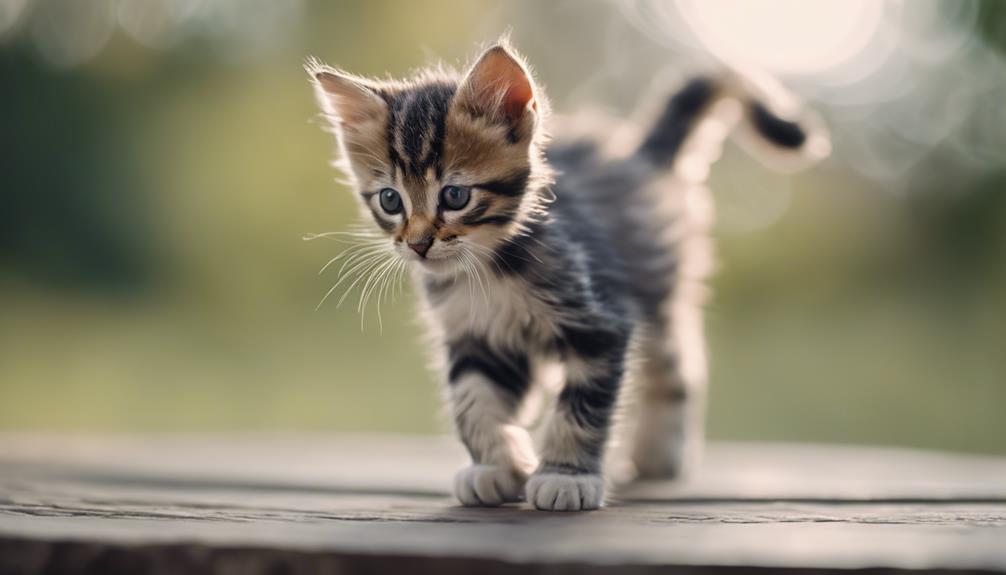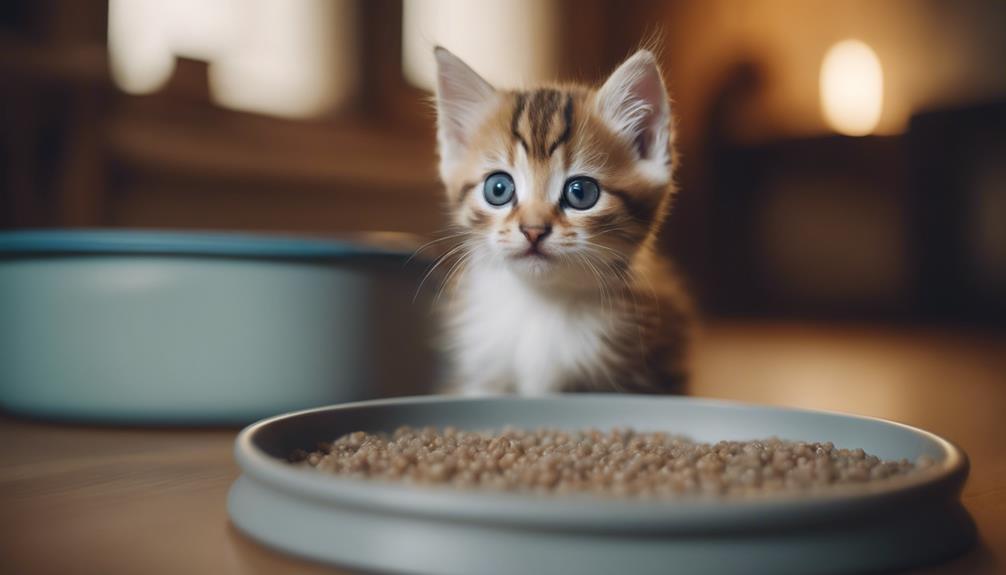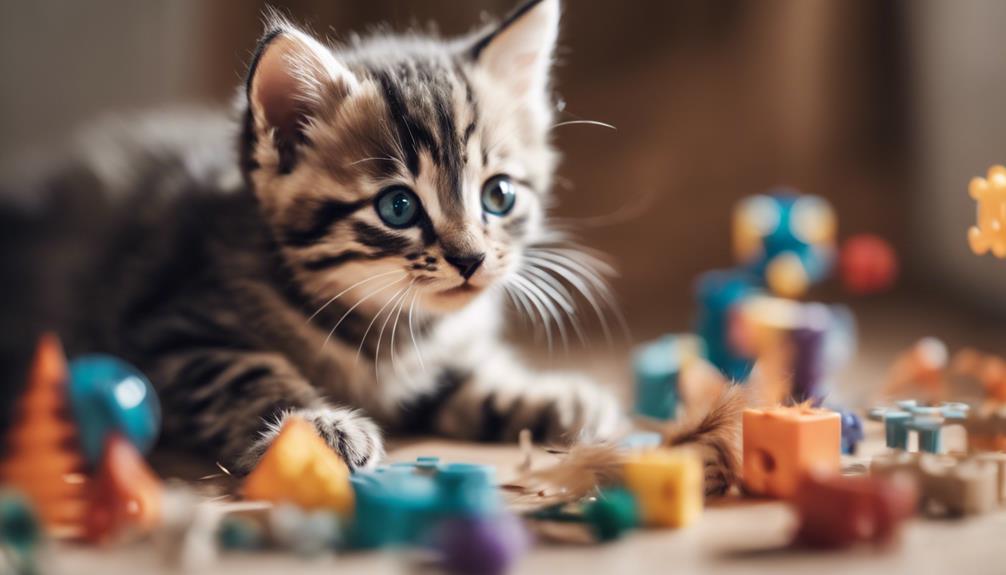Within the realm of feline health, Wobbly Kitten Syndrome, also known as cerebellar hypoplasia, poses unique challenges for cat owners. The manifestations of this condition go beyond mere physical instability, requiring a nuanced approach to care and support.
By uncovering the intricacies of this neurological disorder and exploring tailored strategies, a path towards enhancing the well-being of cats affected by this syndrome emerges. As we delve into the world of wobbly kittens, a deeper understanding of their needs and how to address them with compassion unfolds.
Key Takeaways
- Wobbly Kitten Syndrome is characterized by unstable movement due to an underdeveloped cerebellum.
- The condition is congenital, with causes including in utero influences or exposure to toxins.
- Cats with Wobbly Kitten Syndrome need special care and precautions to prevent injuries.
- While there is no cure, affected cats can live comfortably with proper home adjustments and support.
Understanding Wobbly Kitten Syndrome
Wobbly Kitten Syndrome, characterized by an underdeveloped cerebellum in kittens, results in unstable or uncoordinated movement patterns. The cerebellum, responsible for coordinating voluntary movements, is smaller in affected kittens, leading to symptoms like swaying or tremors.
Typically emerging around 2 or 3 weeks old, the syndrome presents challenges for affected cats in navigating their surroundings. Despite the lack of a cure, these cats can lead fulfilling lives with proper care. Understanding the unique needs of cats with Wobbly Kitten Syndrome is crucial for ensuring their safety and well-being.
Causes and Diagnosis
The etiology and diagnostic evaluation of cerebellar hypoplasia in cats are multifaceted processes that require a comprehensive understanding of potential congenital and acquired factors. Cerebellar hypoplasia in cats is typically congenital, often linked to the mother contracting the panleukopenia virus during pregnancy or other in utero influences.
Additionally, progressive neurologic diseases or exposure to toxins can contribute to the development of this condition. A definitive diagnosis of Wobbly Kitten Syndrome may involve advanced imaging like an MRI, but can also be based on observed symptoms, age, breed, and medical history.
Veterinary professionals may recommend lab work or X-rays to rule out other possible causes of the symptoms. Understanding the various factors that can lead to this syndrome is crucial for accurate diagnosis and appropriate management strategies.
Symptoms and Progression

Symptoms and progression of cerebellar hypoplasia in cats manifest variably depending on the severity of the condition and individual factors influencing the neurological development. Affected kittens may display symptoms such as tremors, swaying, uncoordinated movements, and difficulties with balance.
As kittens age, these symptoms typically remain stable, showing minimal improvement. In severe cases, cats may have challenges with basic activities like walking, grooming, or using the litter box. However, many cats with cerebellar hypoplasia can adapt well to their condition and live fulfilling lives with appropriate care.
Regular monitoring by a veterinarian is crucial to track the progression of the syndrome and address any additional support needed for the cat's well-being.
Veterinary Care and Monitoring
Understanding the optimal veterinary care and monitoring protocols is essential for ensuring the long-term well-being of cats with cerebellar hypoplasia. To provide the best care for your feline companion, consider the following:
- Regular Veterinary Check-ups: Routine visits to the veterinarian are crucial to monitor your cat's overall health and address any specific issues related to cerebellar hypoplasia.
- Diagnostic Testing: Periodic neurological evaluations and imaging studies may be necessary to assess the progression of the condition and make any adjustments to the treatment plan.
- Medication Management: Work closely with your veterinarian to manage any medications your cat may need to alleviate symptoms or address any secondary conditions that may arise.
Home Environment Adaptations

Implementing supportive modifications in the living environment enhances the safety and comfort of cats with cerebellar hypoplasia. Creating a conducive space for your wobbly kitten involves removing obstacles and hazards that could cause accidents. Consider providing low-sided litter boxes for easy access, placing food and water dishes in stable locations, and ensuring that sleeping areas are cozy and secure.
Carpeted or padded surfaces can help prevent injuries from falls, while strategically placed ramps or steps can assist your cat in reaching elevated surfaces. Keep living spaces clutter-free to allow your cat to move around more freely. By making these adjustments, you can create a safe and comfortable environment that accommodates your cat's unique needs.
Nutrition and Hydration Tips
For cats with cerebellar hypoplasia, ensuring proper nutrition and hydration is essential for their overall well-being and health. Here are some tips to help you provide the best care for your feline companion:
- High-Quality Diet: Opt for a balanced and nutritious diet specially formulated for cats with mobility issues. Look for options rich in essential nutrients like omega-3 fatty acids and antioxidants to support overall health.
- Regular Feeding Schedule: Establish a consistent feeding schedule to help your cat maintain a healthy weight and energy levels. Small, frequent meals throughout the day can be beneficial.
- Adequate Hydration: Ensure your cat has access to fresh water at all times. Consider using shallow bowls or pet fountains to make drinking easier for cats with coordination challenges.
Physical and Mental Stimulation

Enhancing enrichment for cats with Cerebellar Hypoplasia is crucial for promoting their physical and mental well-being. Providing opportunities for physical and mental stimulation can greatly benefit these special cats. Here are some ways to engage and entertain your feline companion:
| Physical Stimulation | Mental Stimulation | Interactive Toys | Environmental Enrichment |
|---|---|---|---|
| Gentle play sessions | Puzzle feeders | Feather wands | Cat trees and perches |
| Laser pointers | Hide and seek games | Interactive balls | Window perches |
| Tunnels and tubes | Training sessions | Treat dispensers | Scratching posts |
Support and Community Resources
Accessing Support and Community Resources is vital for pet owners of cats with Cerebellar Hypoplasia to navigate the unique challenges associated with this condition.
- Online Support Groups: Joining online communities like Reddit's r/CerebellarHypoplasia or Facebook groups can provide a platform to share experiences, seek advice, and find solace in connecting with others facing similar situations.
- Local Veterinary Clinics: Establishing a relationship with a veterinary clinic experienced in treating cats with Cerebellar Hypoplasia can offer specialized care and valuable guidance tailored to your feline companion's needs.
- Educational Websites: Websites such as CHCat.org or CerebellarHypoplasiaCats.com offer resources, FAQs, and articles to enhance your understanding of the condition and empower you to provide optimal care for your cat.
Frequently Asked Questions
Can Wobbly Kittens With Cerebellar Hypoplasia Still Lead a Happy and Fulfilling Life?
Yes, wobbly kittens with cerebellar hypoplasia can still lead happy and fulfilling lives with proper care. While there is no cure, providing a safe environment, love, and understanding can help them thrive and enjoy life to the fullest.
Are There Any Specific Toys or Activities That Are Recommended for Wobbly Kittens to Help Improve Their Coordination?
For wobbly kittens with cerebellar hypoplasia, gentle interactive toys like feather wands or balls with bells can encourage coordination. Low-intensity activities such as laser pointers or slow-moving toys help improve motor skills and provide mental stimulation.
How Can Owners Ensure That Their Wobbly Kittens Get Enough Exercise While Also Staying Safe?
To ensure wobbly kittens get enough exercise while staying safe, owners can create a secure, low-risk environment with padded surfaces and limited access to high areas. Encouraging gentle play, interactive toys, and supervised movement can help maintain their physical activity levels.
Are There Any Specialized Products or Equipment Available to Assist Wobbly Kittens in Their Daily Activities?
Specialized products like non-slip feeding bowls, ramps, and low-sided litter boxes can assist wobbly kittens in their daily activities. These items help enhance stability and accessibility, ensuring a safer and more comfortable environment for cats with Wobbly Kitten Syndrome.
Is It Possible for Wobbly Kittens to Live With Other Pets in the Household, and if So, What Precautions Should Be Taken?
It is possible for wobbly kittens to live with other pets, but precautions such as supervised interactions, creating safe spaces, and providing separate feeding areas are important. Monitoring all animals' behaviors helps ensure a harmonious environment for pets with different needs.
Conclusion
In conclusion, Wobbly Kitten Syndrome, or cerebellar hypoplasia, presents unique challenges for cat owners. Understanding its causes, symptoms, and management is crucial for providing optimal support.
By focusing on proactive measures, tailored adjustments to the living environment, proper veterinary care, and nutrition, owners can enhance the quality of life for their wobbly kittens.
Through physical and mental stimulation, as well as accessing support and community resources, individuals can navigate this condition with knowledge and empathy.




